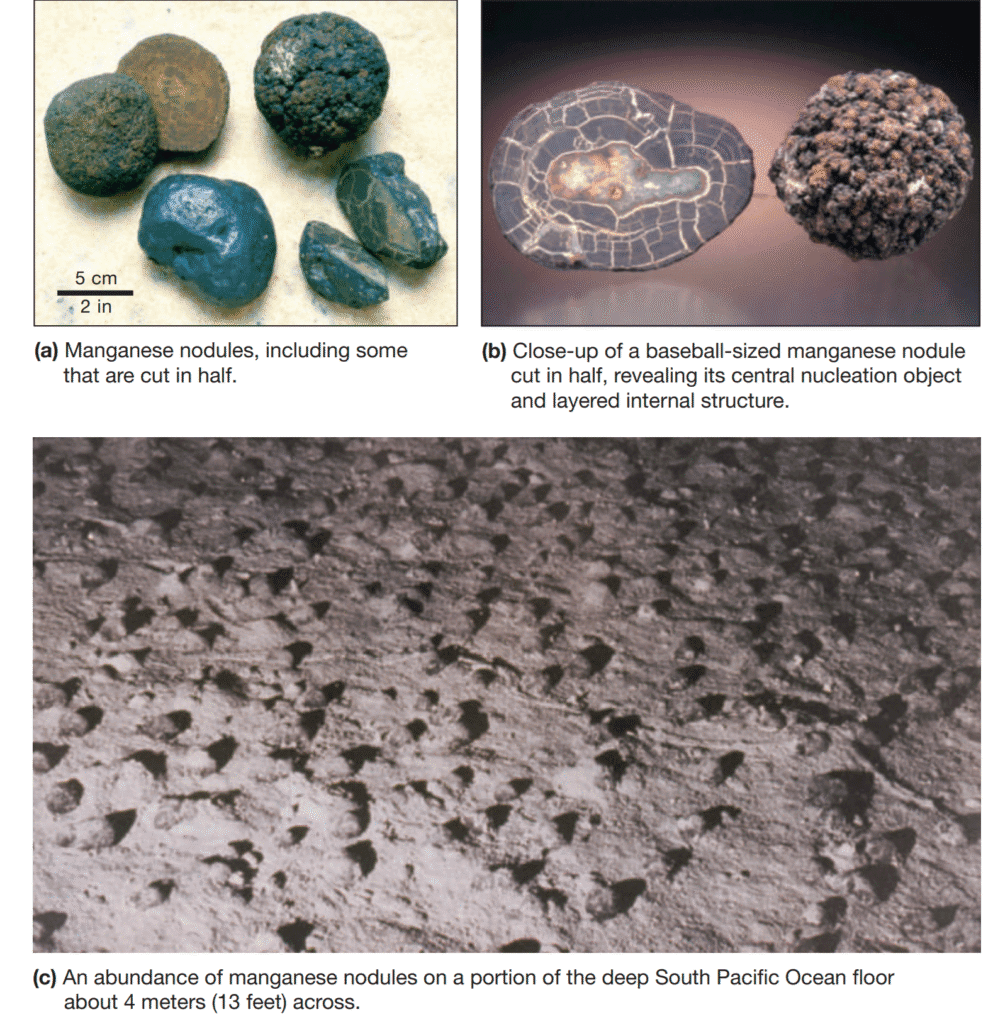Hydrogenous sediment (from hydro, meaning water, and generare, meaning to produce) originates from substances that have been dissolved within aquatic environments.
Origin of Hydrogenous Sediment
Seawater encompasses a vast array of dissolved components. Through various chemical reactions occurring in the marine environment, select minerals are induced to separate from the solution, forming solids through a process termed precipitation (transitioning from a dissolved state to a solid phase). This precipitation is typically initiated by alterations in environmental conditions, such as fluctuations in temperature, pressure, or the introduction of reactive fluids. A comparable scenario can be found in the preparation of rock candy. During this process, a vessel of water is heated, and sugar is integrated. Once the water reaches a high temperature and the sugar is completely dissolved, the container is taken off the heat, allowing the mixture to cool. The decline in temperature results in a supersaturation of sugar, triggering it to precipitate. As cooling continues, sugar crystals form upon any object placed within the solution—such as strings or kitchen tools—demonstrating how environmental shifts lead to precipitation.
Composition and Distribution of Hydrogenous Sediment
Although hydrogenous sediments constitute only a minor fraction of the total sedimentary material within the oceanic environment, they exhibit a diverse composition and are dispersed across a wide range of depositional settings.
MANGANESE NODULES
Manganese nodules are solid, rounded aggregations composed primarily of manganese, iron, and additional trace metals, typically measuring around 5 centimeters (2 inches) in diameter, but occasionally reaching sizes of up to 20 centimeters (8 inches). Upon sectioning, these nodules commonly reveal a concentric layered structure, indicative of their formation through precipitation around a central nucleation core. The nucleation point may consist of a fragment of lithogenous sediment, coral, volcanic debris, a fish bone, or even a shark’s tooth. These nodules are distributed across extensive areas of abyssal plains, with potential coverage reaching nearly 60% of the oceanic basin floor, typically at depths of approximately 5 kilometers (3.1 miles). In some regions, manganese nodules are found in densities of nearly 100 nodules per square meter (or square yard); in exceptional circumstances, their concentration is even more substantial, appearing as a dispersed collection of nodules ranging in size from golf balls to baseballs. The formation of manganese nodules necessitates extremely low deposition rates of lithogenous or biogenous material to prevent burial, ensuring their continued growth and preservation on the seafloor.
The primary constituents of these nodules consist of manganese hydroxide (approximately 30% by weight) and iron hydroxide (approximately 20%). The element manganese holds significant industrial value, particularly in the production of high-strength steel alloys. Additional trace metals present within manganese nodules include copper (utilized in electrical wiring, plumbing systems, and in the manufacturing of brass and bronze), nickel (employed in the fabrication of stainless steel), and cobalt (used in combination with iron to produce durable magnets and specialized steel tools). Although these accessory metals typically occur in concentrations below 1%, they may occasionally surpass 2% by weight, rendering the nodules a potentially valuable resource for future metal extraction initiatives.

The origin of manganese nodules has posed a notable challenge for oceanographic research since their initial discovery in 1872 during the voyage of HMS Challenger. If these nodules are indeed hydrogenous in nature and form via precipitation from seawater, then how do they attain such elevated levels of manganese, given that this element exists in extremely minute concentrations—often below the threshold of accurate measurement—in seawater? Moreover, why do these nodules remain on the surface of the oceanic sediment rather than being buried beneath the continuous accumulation of particulate matter descending from the water column?
Unfortunately, no conclusive explanations currently exist for these phenomena. It is hypothesized that manganese nodules may form through one of the slowest chemical processes known, exhibiting an average growth rate of only about 5 millimeters (0.2 inch) per million years. Scientific investigations propose that bacterial activity and a still unidentified marine organism capable of periodically lifting and rotating the nodules may facilitate their development. Additional research has demonstrated that nodule formation does not occur in a continuous manner but rather in intermittent phases triggered by specific environmental factors, including minimal sedimentation of lithogenous clay and the presence of vigorous deep-ocean currents. Intriguingly, larger nodules tend to exhibit faster growth rates. The origin of manganese nodules remains one of the most intriguing and unresolved questions in the field of marine chemistry.
PHOSPHATES
Phosphorus-rich compounds known as phosphates are commonly found as coatings on rock surfaces and as nodular deposits on the continental shelf and submarine banks at depths shallower than 1000 meters (3300 feet). These deposits frequently contain phosphate concentrations as high as 30% by weight, signifying regions of intense biological activity in the surface waters directly above the accumulation zones. Owing to their agricultural value as fertilizers, ancient marine phosphate beds that have been uplifted onto terrestrial landscapes are now extensively mined to meet modern farming demands.
CARBONATES
The two most fundamental carbonate minerals found in marine sediments are calcite and aragonite. Both minerals are composed of calcium carbonate (CaCO₃), although aragonite possesses a distinct crystalline structure that is less stable and gradually converts into calcite over geological time. Carbonates serve a wide array of purposes, being extensively utilized in the construction sector, especially for cement production, and are also widely applied in medical contexts as calcium supplements and antacid formulations.
As previously explained, the majority of carbonate deposits originate from biogenous sources. Nonetheless, hydrogenous carbonate formations can also result from direct precipitation from seawater, particularly in tropical marine environments, where they form aragonite crystals typically measuring less than 2 millimeters (0.08 inch) in length. Additionally, structures known as oolites (from oo = egg and lithos = rock) are minute calcite spheres, also 2 millimeters (0.08 inch) or smaller in diameter, characterized by layered formations similar to those of an onion. These particles develop in shallow tropical regions where calcium carbonate (CaCO₃) concentrations are significantly elevated. Oolites are believed to form by precipitating around a nucleus, growing progressively larger as they are agitated by wave energy along coastal beaches. However, some scientific evidence suggests that the presence of certain algae may also play a crucial role in facilitating their development.
METAL SULFIDES
Metal sulfide deposits are predominantly linked to hydrothermal activity and the formation of black smokers along mid-ocean ridges. These deposits are composed of various metals, including iron, nickel, copper, zinc, silver, and others, present in differing ratios. As the oceanic crust expands via seafloor spreading, these metal-rich deposits are distributed across the oceanic floor and, in some cases, may even be uplifted onto continental landmasses, demonstrating the broad dispersion and geological significance of such hydrothermal mineral resources.
EVAPORITES
In general, evaporite minerals develop in regions characterized by elevated evaporation rates—typically associated with arid climates—and where oceanic water circulation is restricted. A notable case is the Mediterranean Sea, where substantial layers of evaporite deposits on the seafloor imply that, at a certain point in geological history, the basin may have completely desiccated. In such dry environments, as water evaporates, the concentration of dissolved minerals in the remaining seawater rises until it reaches saturation, initiating precipitation (the conversion from dissolved to solid form). These precipitated minerals, being denser than seawater, either sink to the bottom or accumulate as a white mineral crust along the margins of the evaporating zones.
Collectively known as “salts,” certain evaporite minerals, such as halite (chemically sodium chloride, NaCl, or common table salt), are salty in taste, whereas others—like the calcium sulfate-based minerals anhydrite (CaSO₄) and gypsum (CaSO₄·H₂O)—lack this saline flavor. These evaporitic formations are indicative of distinctive environmental conditions and represent an important component of marine sedimentary geology.
Reference: All images and content are taken from Essentials of Oceanography by Alan P. Trujillo and Harold V. Thurman, 12th Edition.
